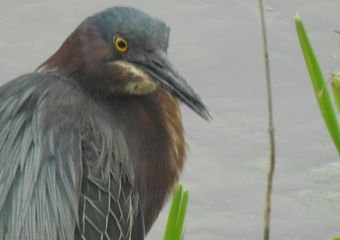Green Heron
Common Name: Green Heron.
Scientific Name: Butorides Virescens.
What to look for? Do not let the name “Green Heron” fool you. Your typical Great Blue Heron is tall, lanky, long necked, and long legged. The Green Heron is opposite: short, stocky, no readily visible neck (more on the neck later) and short legged. And “green” – with the typical wetlands lighting around the wooded shoreline, Green Herons simply look dark as silhouettes along the banks of Carillon Stonegate Pond! In better light, they are deep greenish-blue on the back with a rich chestnut breast and neck. While their neck is long and thick, because they keep it drawn up against their body, it is hardly noticeable. Their wings are broad and round. The bill is long and daggerlike. And their short legs are yellowish.
Where can they be found at Carillon Stonegate Pond? While Green Herons are quite common, they are said to be shy birds such that they are rarely observed. So, with that caveat, look around the banks of Carillon Stonegate Pond – especially the western pond with some trees on the northern bank. You may find a Green Heron sitting on the bank or on one of the fallen tree trunks patiently waiting for fish to arrive near shore. Seasonally, they will be around in late spring through the summer.
How big are they? Short and stocky for a heron! The Green Heron averages approximately seventeen inches in length. And their wingspan is just over twenty-six inches. They weigh in at approximately eight to nine ounces.
What are their flight patterns? Green Herons are distinctive in flight with slow, steady beats of their rounded wings. And, in flight, they may briefly unfold their neck, giving a very recognizable image. They also perform display flights to announce or mark their territory.
How else do they behave? Green Herons stand motionless at the edge of Carillon Stonegate Pond as they hunt for fish and amphibians. Sometimes they actually “fish” and use "bait." They will drop fish food pellets, bits of bread (from people feeding birds and ducks at a park), or flower petals into the water to lure fish within striking distance. Green Herons also have a characteristic slow, deliberate walk. But it is their ability to stretch that short, "no neck" neck that is startling. In fact, that is when they are most likely to "stretch" it. When the Green Heron is startled, it will stretch its neck up as far as it will go (see photos).
What’s for dinner? Mostly fish. Green Herons eat mainly small fish such as minnows, sunfish, and catfish. They will also dine on crayfish and other crustaceans, aquatic insects, frogs, and tadpoles.
Where do they take up residence? Green Herons reside across the eastern U.S. during the summer into early fall. Their habitat includes wooded ponds, marshes, rivers, and estuaries. Green Herons are common breeders in coastal and inland wetlands. They winter primarily in Mexico and Central America.
When and where do they breed and nest? Green Herons will breed during late spring across the eastern U.S. According to Illinois Department of Natural Resources, the Green herons begin arriving in Illinois in April and nesting occurs from May through early July. They nest in trees, usually near water. They may lay up to five eggs that will incubate for approximately three weeks. The young usually climb about near the nest around two weeks after hatching. They will make their first flight over the following week. They generally have one brood per year.
Where do they migrate? In Illinois, Green Herons are common migrants. They migrate north in the spring across most of the eastern U.S. to breed, including Illinois. They will migrate south around August and spend winters in Florida, Mexico, and Central America.
What is their conservation status? Green Herons are classified as a Low Concern. Green Herons are still common, although their population shows steady decline of 1.8% annually, according to the North American Breeding Bird Survey.
Do they make any interesting sounds? Green Herons give a harsh “skeow” call that is a distinctive sound of the wetlands where they reside. Here is a link to the sounds of the Green Heron.
Interesting Facts About Green Herons:
-
Green Herons sometimes lure in fish using small items such as twigs or insects as bait.
-
Unlike the fishermen that we see at Carillon Stonegate Pond who change locations every five minutes, the Green Heron is patient, standing still in one place and waiting for prey to approach them.
-
They nest as isolated pairs or in small groups, rarely in large colonies as the Great Blue Heron does.
-
Green herons have especially acute vision and hearing.
-
The oldest recorded Green Heron was approximately 8 years old.
For more information on the Green Heron and sources of information used in this blog (these are the sources that I am using to learn as I blog), please visit All About Birds, Audubon Society, Nature Mapping Foundation and University of Michigan Animal Diversity Web. And the Cornell Lab of Ornithology provides a wonderful source of information for anyone interested in learning more about birds.
The Carillon at Stonegate community is very fortunate to have a variety of wetland, forest and prairie environments conducive to a variety of birds and other wildlife, plants and insects. Our community and the Kane County Forest Preserve do an exceptional job in maintaining this natural environment – both for the benefit of the birds and wildlife and for our residents to enjoy.
Take a hike and see what you can find – and identify!
























